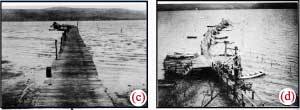G.K. Gilbert on Large Strain Deformation of Mud At Inverness, Tomales Bay During the San Francisco Earthquake, 1906
Click on photos for enlargement (36K), (32K), (40K), (36K)
 |
|
 |
| Text from G.K. Gilbert (Lawson, et al., 1908): (a) 'Ridged mud plain', ...'it would seem that in the production of this ridging the tidal mud must have behaved as a quasi liquid, being thrown into waves by the agitation to which it was subjected'., (b) 'There was also a horizontal shifting of mud over a considerable area.', 'At various places along the shore...the tidal mud seemed crowded against the firmer ground at the shore, being pushed up into a ridge', (c) At Martinelli's Pier, '...more than half the pier, the part nearer the shore, remained straight... . The outer part suffered most violence near the junction of the shifting mud with the firmer ground, being there so completely wrecked that the platform fell down.' 'Maximum shifting...was not less than 30 feet'. (d) 'In the case of Bailey's pier,...nearly the whole structure was transported by the shifting mud'. |
|







